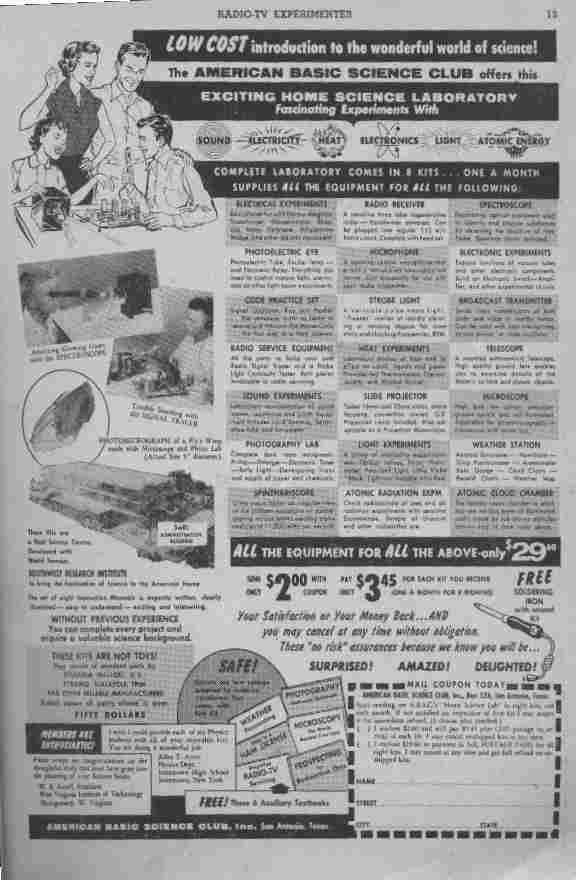
I subscribed to it within a week (the COD option), with the first kit coming rapidly in early May. It dealt mostly with electrostatics and battery DC circuits.
Kit 2, later in May, provided the transformer and a 35Z5GT rectifier tube and associated filtering components. (I learned the resistor color code then WITHOUT the need of any raunchy mnemonics!)
Kit 3, during the summer, expanded on this with additional VT(s) Found out VERY quickly why acid-core solder is an electronic no-no!
Kit 4, by August, completed the electronic phase with the regenerative receiver (am broadcast) now intact. That also contained the Q&A booklet for the Novice Exam.
Kit 5 dealt with optics (microscope)
Kit 6 presented the spectroscope and other optical features
Kit 7, Feb 1959, was the photographic unit. I only managed to make some poor contact print/enlargements, getting introduced to the 3-trays of photo bath solutions. The booklet on radio servicing with a signal tracer helped me first fathom what a superhet receiver was and how XL and XC cancel at resonance.
Kit 8, the last, dealt with weather AND nuclear physics (cloud chamber) and was very late (due to a heavy backlog) - like mid-August 1959.
Using ethanol (ethyl alcohol) and dry ice (obtained from the traveling ice cream truck) it took about 2 hours to get things working right and see the alpha particle tracks zipping out from the radium-coated pin head stuck in a cork. That cloud chamber later served me well in Junior High and High School, and was even the basis of a term paper in my UT Senior year (1971) Nuclear Physics course!
I never did get the auxiliary booklet on Weather Forecasting though.
All in all, a far superior level of science instruction than my 5th-6th grade elementary school was offering at the time (and this IS after the October 1957 panic that the Soviet Sputnik launch caused with US school science curricula).
There is a little bit of hype in the ad. Many of the items listed would have to be dismantled in order to create a subsequent project. For instance, the plastic cloud chamber also served as the housing for the anemometer shaft spinning a magnet over a coil. (Used, though never calibrated, during the September 1961 Hurricane Carla approach/passage here.)
Some of the projects would entail such serious modification of a component that it could never be used for anything else again (I kept the projection lamp intact rather than using it as the main part of an aneroid barometer!)
Calling a rolled up paper cone attached to the armature of a vibrating relay a loud speaker, which while technically accurate, was a bit of a let down.
I only met the founder of the ogranization, James S. Kerr, once - while getting a replacement downtown for a screw-in neon glow lamp that had been the victim of a "floor encounter".
I believe that by the mid-60's that they had either merged with some other similar science kit company or simply gone out of production. I've done some WWW searches, but only this lone hit has turned up. And, of all things, it shows their cloud chamber (near the end of a long page)!
More-Recent Links (some open new browser windows) early 1960's Kit set version later standalone Atomic Energy Kit in detail Many times these kits can found as unassembled, standalone items on E-bay, leading to some mixed emotions (1) nice to have a pristine sample, but (2) wondering who might have thus missed the learning experience of using them! Since late 2003 I've been offering a CD-R with 100-dpi (some 150-dpi) jpeg scans of my complete set of 8 Kit Manuals and 6 Supplemental Booklets from the 1958-59 ABSC Era along with other images of associated surviving parts. These Kits evolved so rapidly that many later members would find this very early-era documentation not fully matching with their own experiences. Use the e-mail from the gif image at the bottom of the index page for this wa5iyx site for additional details if interested in obtaining a copy.
Nov 27, 2005 SA Express-News Article SA Express-News J. S. Kerr Obituary - Sept 24, 2006 SA Express-News J. S. Kerr Obituary - Sept 28, 2006 Oct 1, 2006 SA Express-News Article
Return to My BioPage Created: September 9, 2000 Last Modified: October 2, 2006